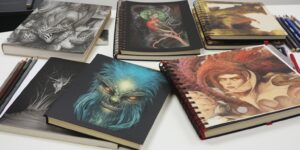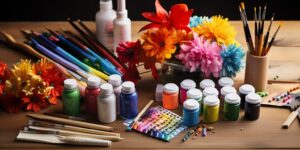Mastering Art: A Guide on How to Use Watercolor Paints

Welcome to our comprehensive guide on how to use watercolor paints. Whether you’re a beginner or a seasoned artist, this guide will provide you with the knowledge and tools to create stunning watercolor artwork. In this section, we will introduce essential techniques and tips to help you get started with watercolor painting.
Watercolor painting is a versatile medium that allows you to create a range of effects and styles. With the right techniques and supplies, you can achieve beautiful, vibrant works of art. In this guide, we will cover everything from understanding watercolor art supplies to choosing the right techniques. We will also take you through a step-by-step watercolor painting tutorial and provide you with expert tips for achieving stunning effects.
So, whether you’re looking to explore the world of watercolor painting or simply want to improve your skills, you’ve come to the right place. Let’s dive in and learn how to use watercolor paints!
Understanding Watercolor Art Supplies
Watercolor painting requires specific art supplies to achieve the desired effect. Understanding what supplies you need is crucial to the success of your watercolor paintings. Let’s take a look at some must-have watercolor art supplies you’ll need to get started.
Watercolor Paints
The first supply you’ll need to create stunning watercolor paintings is the paint itself. Watercolor paints come in many forms, including tubes, pans, and liquid. You can choose to use student-grade or artist-grade paints, depending on your skill level and budget.
Watercolor Paintbrushes
The right paintbrush can make all the difference in your watercolor paintings. Watercolor paintbrushes come in many shapes and sizes, including flat, round, and filbert, and each one has its unique purpose. It’s essential to have a wide range of brushes to create different effects and textures in your artwork.
Watercolor Paper
Watercolor paper is specially designed to absorb and hold watercolor paints. It’s important to choose the right paper for your paintings, as the wrong type of paper can cause the paint to bleed and not adhere properly. Look for watercolor paper that is acid-free and has a textured surface for optimal results.
Water Containers
You’ll need a container to hold water for cleaning your brushes and diluting your paint. You can use any container that is large enough to hold your brushes and allow them to move around freely.
Palette
A palette is essential for mixing and blending your watercolor paints. You can use a traditional plastic or ceramic palette or opt for a makeshift palette using a plate or even a piece of cardboard.
Masking Tape
Masking tape can be used to create crisp edges and protect areas of your painting that you don’t want to get wet or painted over. It’s especially useful when painting architectural or geometric shapes.
Easel
While not necessary, an easel can be helpful when painting with watercolors. It allows you to keep your painting at a comfortable height and angle, reducing strain on your neck and back.
These are just some of the essential watercolor art supplies you’ll need to create stunning artwork. With the right materials and tools at your disposal, you can unleash your creativity and produce beautiful watercolor paintings.
Choosing the Right Watercolor Techniques
Watercolor painting offers a vast range of techniques to create different effects. If you’re new to watercolor painting, it can be overwhelming to choose the right technique to use. Here are some popular watercolor techniques to help you get started.
Wet-on-Wet Technique
The wet-on-wet technique involves applying wet paint to a wet surface. This technique creates a soft, blurry effect and is ideal for creating backgrounds or blending colors seamlessly. To achieve this effect, wet your paper first and then apply the paint. You can also add more color to the wet paint, allowing the colors to blend together.
Dry Brushing Technique
The dry brushing technique involves using a dry brush to apply paint to a dry surface. This technique creates a textured and grainy effect and is ideal for creating depth or emphasizing details. To achieve this effect, use a dry brush with minimal water and apply the paint in short, quick strokes.
Glazing Technique
The glazing technique involves layering translucent layers of paint over each other. This technique creates a luminous effect and is ideal for creating depth or adding richness to your artwork. To achieve this effect, apply a thin layer of paint and let it dry completely before adding another layer.
As a beginner, it’s important to take your time and experiment with these techniques. Don’t be afraid to make mistakes and try different methods until you find what works best for you. Remember to have fun and enjoy the process of creating beautiful watercolor art!
Watercolor Painting Techniques for Beginners
If you’re a beginner, it’s important to start with simpler techniques and gradually work your way up. Here are some tips to help you get started:
- Practice on scrap paper before moving onto your final piece.
- Start with simple shapes and gradually add more detail.
- Use light washes of color and build up the intensity gradually.
- Experiment with different brush sizes and shapes to achieve different effects.
Watercolor Mixing Techniques
Mixing colors is an essential aspect of watercolor painting. Here are some tips to help you create harmonious color blends:
- Use a color wheel to determine which colors work well together.
- Start with a small amount of paint and add more as needed.
- Use minimal water when mixing paint to achieve a vibrant color.
- Test your color mix on scrap paper before applying it to your final piece.
Understanding Color Theory in Watercolor Painting
Color theory plays an important role in watercolor painting. By understanding the basics of color theory, you can effectively mix and blend colors to create beautiful and harmonious artwork.
Color Basics
Colors can be broken down into three categories: primary, secondary, and tertiary. Primary colors are red, blue, and yellow, and cannot be created by mixing other colors. Secondary colors are created by mixing two primary colors, such as green (yellow + blue) and purple (red + blue). Tertiary colors are created by mixing a primary color with a secondary color, such as yellow-green or blue-purple.
Color Harmony
When creating a watercolor painting, it’s important to consider color harmony. There are several color harmonies you can use to create a visually appealing artwork:
- Complementary colors: Colors that are opposite each other on the color wheel, such as blue and orange or red and green. These colors create a high contrast and dynamic effect.
- Analogous colors: Colors that are adjacent to each other on the color wheel, such as blue, blue-green, and green. These colors create a harmonious and calming effect.
- Monochromatic colors: Different shades and tints of a single color. This creates a simple and elegant effect.
Color Mixing
Once you understand the basics of color theory, you can begin mixing colors to create your desired shades and hues. It’s important to start with a light wash of each color and gradually add more pigment as needed. When mixing colors, it’s important to use a color palette to keep track of the ratios and avoid creating too much of one color.
Experimenting with color mixing can be fun and can lead to unexpected and beautiful results. Don’t be afraid to try new combinations and techniques to create your unique artwork.
Tips for Vibrant Color in Watercolor Painting
If you want to achieve vibrant colors in your watercolor paintings, there are a few tips you can follow:
- Use high-quality paints: High-quality paints have a higher concentration of pigment, resulting in more vibrant colors.
- Limit the use of water: Using too much water can dilute the pigments and result in dull colors.
- Layer colors: Layering colors can create depth and vibrancy in your artwork. Just make sure each layer is completely dry before adding another layer.
- Experiment with different techniques: Different techniques, such as dry brushing and glazing, can create unique effects and add vibrancy to your artwork.
By understanding color theory and following these tips, you can create stunning watercolor paintings full of vibrant colors and beautiful harmonies.
Step-by-Step Watercolor Painting Tutorial
Ready to put your new watercolor painting knowledge to the test? Follow along with our step-by-step tutorial to create a beautiful watercolor painting from start to finish.
Step 1: Choose Your Subject
First, select a subject for your painting. Choose something that inspires you and is manageable for your skill level. For beginners, we recommend starting with a simple subject, such as a flower or fruit.
Step 2: Sketch Your Design
Sketch your subject lightly on your watercolor paper using a pencil. Keep the lines simple and focus on the overall shape and composition. Don’t worry about adding details at this stage.
Step 3: Block in Your Colors
With your watercolor paints and brushes ready, begin blocking in the basic colors of your subject. Apply the paint in thin, even washes using a large brush. Don’t worry about adding details yet, focus on filling in the shapes with color.
Step 4: Add Details and Depth
Once the basic colors are dry, begin adding details and depth to your painting. Use smaller brushes to add texture and detail to the subject. Use darker colors to add depth and shadows to your painting.
Step 5: Final Touches
Review your painting and make any final touches necessary. Add highlights to areas that need a pop of brightness, or darken shadows even further for extra depth. Take a step back and admire your finished watercolor painting!
Remember, practice makes perfect. Don’t be discouraged if your first attempt doesn’t turn out as expected. Keep experimenting with different techniques and subjects, and you’ll soon be creating stunning watercolor artwork.
Tips for Achieving Stunning Watercolor Effects
Watercolor painting offers a range of techniques that can be used to create stunning effects. Here are some tips to help you take your watercolor paintings to the next level:
Experiment with Different Techniques
Don’t be afraid to experiment with different watercolor painting techniques to see what works best for you. Try wet-on-wet, dry brushing, and glazing to achieve different effects and textures in your paintings.
Create Texture
Watercolor painting allows for the creation of unique textures that can add depth and interest to your artwork. Try using a salt or alcohol technique to create a granulated effect or a plastic wrap technique to create a textured look.
Use Gradients
Gradients are another effective way to create depth and visual interest in your watercolor paintings. Try blending two or more colors together to create a gradient effect, which can be used to create a sense of perspective or to highlight certain areas of your painting.
Get Creative with Color
Experiment with different color combinations to create harmonious and eye-catching palettes. You can also try using complementary colors to create contrast and depth in your artwork.
Add Details with Ink
If you want to add finer details to your watercolor paintings, consider using ink. Pen and ink can be used to add outlines and details to your painting without compromising the delicate watercolor washes.
Practice, Practice, Practice
Finally, the key to achieving stunning watercolor effects is practice. Don’t get discouraged if your first few paintings don’t turn out the way you want them to. Keep practicing and experimenting with different techniques, and soon you’ll be creating beautiful watercolor artwork!
Common Mistakes to Avoid in Watercolor Painting
Watercolor painting is a beautiful medium for creating stunning artwork, but it can also be challenging, especially for beginners. To help you avoid some common pitfalls, we’ve put together a list of tips to keep in mind when painting with watercolors.
Overworking the Paint
One of the most common mistakes in watercolor painting is overworking the paint. You may be tempted to keep adding layers and details to your painting, but this can lead to a muddy and overworked result. Instead, try to work quickly and confidently, using deliberate strokes. If you need to make corrections, wait for the paint to dry before adding more layers.
Using Too Much Water
Water is an essential part of watercolor painting, but using too much water can cause your colors to become diluted and fade. Try to use the minimum amount of water necessary to achieve the desired effect, and don’t forget to dry your brush before loading it with paint. This will help you control the flow of your paint and keep your colors vibrant.
Not Planning the Composition
Before starting your painting, take a moment to plan your composition. Think about the placement of your subject, the colors you’ll be using, and the overall mood you want to convey. By having a clear plan in mind, you can avoid creating a painting that lacks focus or cohesion.
Skipping the Sketching Phase
Sketching is an essential part of any painting, as it allows you to work out the composition and proportions before adding color. Even if you’re painting from a reference photo, take some time to sketch out your subject on paper. This will help you avoid mistakes and make adjustments before committing to paint.
Not Experimenting with Techniques
Watercolor painting offers a variety of techniques that can be used to achieve different effects. If you stick to the same techniques every time you paint, your artwork may start to feel stagnant. Instead, try experimenting with different techniques, such as wet-on-wet, dry brushing, and glazing. This will help you keep your artwork fresh and exciting.
By keeping these tips in mind, you can avoid some of the most common mistakes in watercolor painting and create beautiful artwork that you’ll be proud to display. Remember, practice makes perfect, so don’t be discouraged if your first few attempts don’t turn out as expected. Keep experimenting and refining your technique, and soon you’ll be creating stunning watercolor paintings like a pro!
Conclusion
Congratulations, you have reached the end of our guide on how to use watercolor paints! We hope you found this tutorial informative and helpful in improving your watercolor painting skills.
Remember, watercolor painting is an art form that requires patience, practice, and experimentation. Don’t be afraid to try new techniques and make mistakes – that’s how you learn and grow as an artist.
Whether you’re a complete beginner or a seasoned painter, we believe that everyone can benefit from incorporating watercolor paints into their artwork. With the tips and techniques outlined in this guide, you can start creating beautiful watercolor paintings in no time.
So grab your paintbrushes, assemble your supplies, and let your creativity flow. Happy painting!
FAQ
What are watercolor paints used for?
Watercolor paints are used to create beautiful artwork using a water-based medium. They are popular among artists for their vibrant colors and unique transparency.
What are some essential watercolor painting techniques?
Some essential watercolor painting techniques include wet-on-wet, dry brushing, and glazing. These techniques allow artists to create different effects and textures in their artwork.
What materials do I need to start watercolor painting?
To start watercolor painting, you will need watercolor paints, brushes, watercolor paper, a palette for mixing colors, and water for diluting the paint.
How do I mix and blend colors in watercolor painting?
To mix and blend colors in watercolor painting, you can use a wet-on-wet technique by applying wet paint to wet paper. You can also layer colors by letting each layer dry before applying the next.
Can I use watercolor paints as a beginner?
Yes, watercolor paints are suitable for beginners. They are versatile and easy to work with, allowing beginners to experiment and learn different techniques.
What are some common mistakes to avoid in watercolor painting?
Some common mistakes to avoid in watercolor painting include overworking the paint, using too much water, and not planning the composition. It’s important to take your time and practice patience in the painting process.







